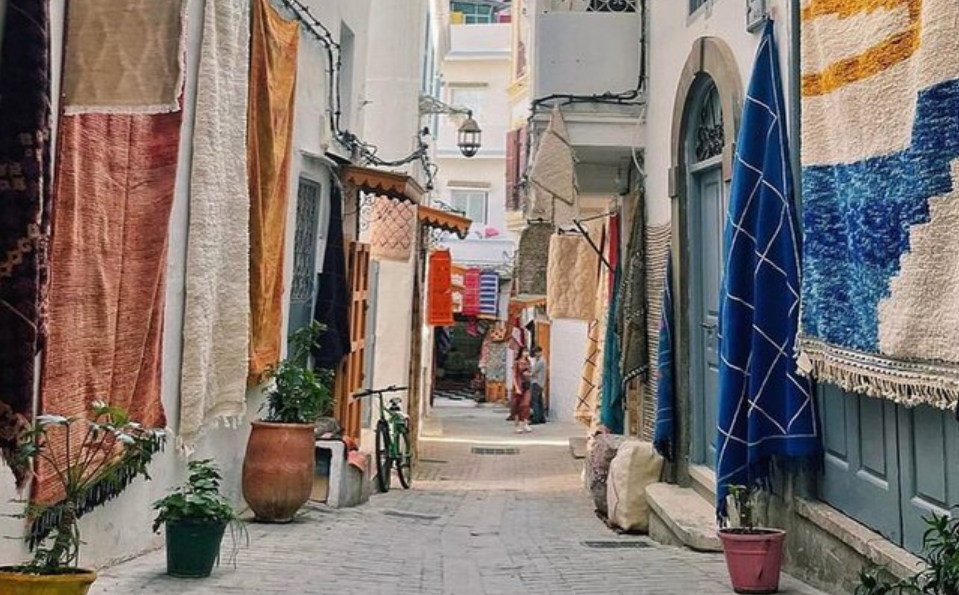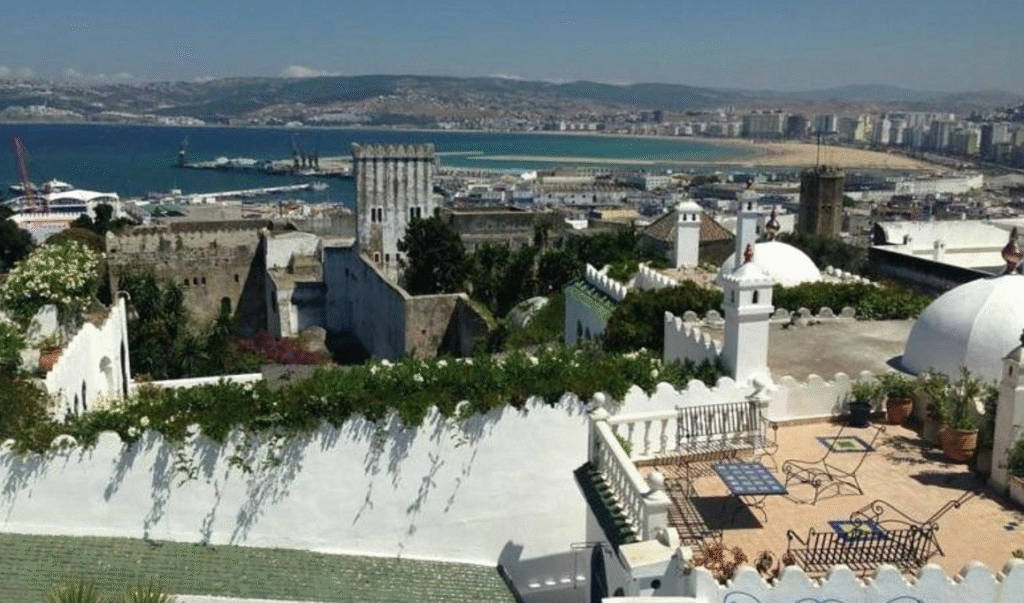Perched atop Tangier’s highest hill, overlooking the Strait of Gibraltar, the Kasbah of Tangier is a historic fortress that encapsulates the city’s essence as a crossroads of African, European, and Mediterranean cultures. This ancient citadel, with its maze-like alleys, whitewashed walls, and vibrant zellij tiles, is a living testament to Tangier’s rich past and dynamic present. Far more than a scenic backdrop, the Kasbah offers a tapestry of experiences—stunning views, immersive history, vibrant arts, and a culinary scene that blends tradition with innovation. Whether you’re wandering through centuries-old ramparts, exploring museums, or savoring a tagine in a jasmine-scented courtyard, the Kasbah is a must-visit destination that captures the soul of Tangier. Here’s why you should make it the heart of your Tangier adventure.
A Historical Treasure Trove
The Kasbah’s history stretches back to Phoenician times, with layers of Roman, Arab, Portuguese, and English influence shaping its identity. Built in the 10th century, the fortress served as a strategic stronghold, housing sultans and defending against invaders. The Dar el-Makhzen, a 17th-century palace now home to the Kasbah Museum, is a highlight. Its Andalusian courtyard, adorned with carved stucco and cedar ceilings, showcases Roman mosaics, Moroccan artifacts, and manuscripts tracing Tangier’s role in global trade. The museum’s garden, shaded by orange trees, offers a serene escape with views of the medina.

The Kasbah’s ramparts, dotted with cannons, provide a tangible link to its military past, while the Bab el-Bahr gate opens to sweeping vistas of the port. Guided tours, often led by local historians, bring stories of sultans, pirates, and colonial powers to life, making every step a journey through time. For history buffs, the Kasbah is a living chronicle of Tangier’s cosmopolitan legacy.
Breathtaking Views and Serene Ambiance
The Kasbah’s elevated position offers some of Tangier’s most spectacular views. From Place du Mechouar, gaze across the Strait of Gibraltar to Spain’s coastline, where the Atlantic and Mediterranean converge in a mesmerizing dance of currents. The ramparts are perfect for sunset strolls, when the sky blazes with hues of amber and rose, casting a golden glow over the medina’s rooftops. The Kasbah’s serene ambiance, with its narrow alleys and hidden courtyards, feels worlds away from the bustling Grand Socco below.

Cafés like Le Salon Bleu enhance the experience, offering rooftop terraces where you can sip mint tea while soaking in panoramic vistas. The sound of distant waves and the scent of jasmine create a tranquil retreat, ideal for photographers, romantics, or anyone seeking a moment of peace. The Kasbah’s blend of natural beauty and historic charm makes it a visual and emotional feast.
A Vibrant Cultural Hub
The Kasbah has long been a magnet for artists, writers, and musicians, from Henri Matisse, who painted its vivid colors, to the Beat Generation’s William S. Burroughs. Today, it remains a cultural epicenter. The Kasbah Art Gallery, housed in a restored riad, showcases contemporary Moroccan and international works, blending traditional calligraphy with modern abstracts. Street art adorns alley walls, reflecting Tangier’s bohemian spirit.
Live music fills the air, with Gnawa and Andalusian performances in riads like Dar Nour or Café Colón, a historic haunt of literary giants. Cultural festivals, such as the Tanjazz music festival, often spill into the Kasbah, bringing global sounds to its ancient stones. Visitors can join workshops on zellij tile-making or Arabic calligraphy, immersing themselves in Morocco’s artistic heritage. The Kasbah’s creative pulse makes it a haven for those seeking inspiration.
4Culinary Delights: A Taste of Tangier’s Soul
The Kasbah’s dining scene is a sensory journey, blending Berber, Arab-Andalusian, French, and Mediterranean influences. Traditional eateries serve couscous, bessara (fava bean soup), and pastilla—a sweet-savory filo pastry with pigeon or chicken. Fine dining venues like El Morocco Club offer innovative dishes, such as seafood pastilla with French emulsions, in elegant riads with live jazz. International spots, tucked in alleys, fuse global flavors—think Spanish tapas with harissa or sushi with preserved lemons.
Plant-based travelers are well-catered, with vegan tagines and mezze crafted from souk-fresh produce. Street stalls near Place de la Kasbah grill kofta and serve spicy babbouche (snail soup), their aromas mingling with the sea breeze. Rooftop dining, like at Le Nabab, pairs lamb tagine with Strait views, while courtyard riads offer communal rfissa under lantern light. Every meal in the Kasbah is a cultural story, served with Morocco’s signature hospitality.
Immersive Exploration: Wandering the Alleys
Exploring the Kasbah’s labyrinthine alleys is an adventure in itself. Narrow streets, lined with turquoise shutters and bougainvillea, lead to hidden squares and artisan shops selling leather goods, ceramics, and Berber rugs. The Bab Kasbah gate, with its ornate arch, welcomes visitors into a world of discovery. Unlike the medina’s hustle, the Kasbah feels intimate, with locals greeting you with “Salam Alaikum.”
Guided walking tours, available for 150–300 MAD, offer insights into the Kasbah’s architecture and history, while self-guided strolls reward the curious with unexpected finds—a tucked-away café or a rooftop view. The Kasbah’s compact size makes it walkable, but comfortable shoes are a must for its uneven cobblestones. Whether you’re chasing history or simply soaking in the vibe, wandering the Kasbah feels like stepping into a living postcard.
Practical Tips for Visiting the Kasbah
To ensure a seamless visit, keep these tips in mind:
- Timing: Visit early (8:00 AM–10:00 AM) to avoid crowds, especially in summer. Sunset is ideal for views and cooler temperatures.
- Kasbah Museum Hours: Open Wednesday–Monday, 10:00 AM–6:00 PM; closed Tuesdays. Entry costs 20 MAD.
- Dining Hours: Lunch is 1:00 PM–3:00 PM; dinner is 8:00 PM–10:30 PM. Many eateries close between services.
- Reservations: Book fine dining spots like El Morocco Club via Google Maps or Instagram, especially during holidays.
- Etiquette: Greet locals with “Salam Alaikum” and dress modestly (covered shoulders and knees) to respect the area’s heritage.
- Tipping: Tip 10–15% at restaurants unless a service charge is included.
- Safety: Drink bottled water and choose street vendors with high turnover. Avoid raw salads from unknown sources.
- Getting There: A 10-minute walk from the Grand Socco or a petit taxi (10–20 MAD) from downtown Tangier. Parking is limited, so walking or taxis are best.
- What to Bring: A light jacket for windy evenings, sunscreen, and a small amount of cash (MAD) for shops and cafés.
Accessibility and Family-Friendly Appeal
The Kasbah is easily accessible from central Tangier, making it a perfect half-day or full-day adventure. Petit taxis or a short walk from the medina bring you to its gates, and the compact layout suits all ages. Families will enjoy the Kasbah Museum’s interactive exhibits and the open spaces of Place du Mechouar, where kids can run freely. Nearby cafés offer kid-friendly dishes like couscous or flatbreads.
While some alleys have steps, main paths are stroller-friendly, and locals are quick to assist. The Kasbah’s sensory delights—colorful tiles, sea breezes, and street music—captivate children and adults alike. For a fun twist, hire a guide to share kid-friendly stories of pirates and sultans, turning the visit into a treasure hunt through history.
Why the Kasbah Stands Out
The Kasbah of Tangier is more than a destination—it’s an experience that weaves together history, culture, and sensory delights. It’s where you can trace the footsteps of Phoenicians, stand where sultans ruled, and feel the creative spark that inspired Matisse and Bowles. The fortress’s views, from the Strait’s shimmering waters to the medina’s rooftops, are unmatched, while its alleys pulse with life, art, and flavor. Whether you’re exploring the Kasbah Museum, dining on a rooftop, or simply wandering its streets, the Kasbah offers a journey that’s as enriching as it is enchanting.
Unlike tourist-heavy sites, the Kasbah retains an authentic charm, with locals living and working amidst its walls. Its proximity to the medina and port makes it an ideal anchor for a Tangier visit, pairing easily with nearby attractions like the Caves of Hercules or Cape Spartel. Make time for the Kasbah, and let it leave an indelible mark on your heart—a vibrant, multifaceted gem that embodies the spirit of Tangier.
